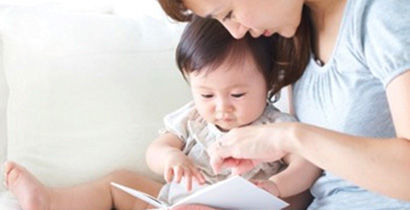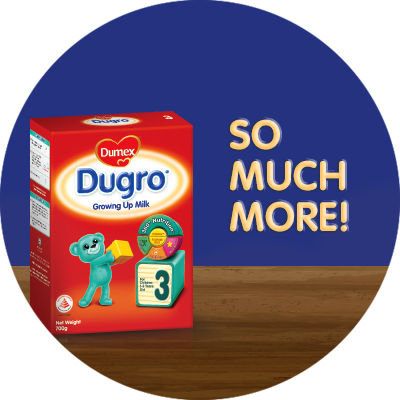Breastfeeding is the best for babies and a healthy diet / maternal nutrition is important when breastfeeding. A decision not to breastfeed can be difficult to reverse. Infant formula is suitable from birth when babies are not breastfed. It is recommended that all formula milks be used on the advice of a doctor, midwife, health visitor, public health nurse, dietitian, pharmacist, or other professional responsible for maternal and child care and the financial implications should be considered. All preparation and feeding instructions should be followed carefully as inappropriate preparation could lead to health hazards.
Babies Need Books by Ms Fauziah Hassan Mohamed
Parents know that reading is a good habit to inculcate in their babies. However, most are unsure of the types of books appropriate for the different age groups and how they should go about reading to their babies.
To address these questions and more is Ms Fauziah Hassan Mohamed, a Senior Librarian who specializes in the area of children's services with the Woodlands Regional Library of the Singapore National Library Board (NLB).
'You may have tangible wealth untold;
Caskets of jewels and coffers of gold
Richer than I you can never be -;
I had a mother who read to me.'
'The Reading Mother' by Strickland Gillian, from 'Best Loved Poems of the American People'
A Serving of Reading
Along with the wonderful array of colourful toys, games, clothes, food and vitamins that you provide for, your children must be wheedled to accept books and reading as an essential part of his/her life. When you give your children a serving of reading everyday, you're laying the foundations for a hale and hearty life of good intellect and enviable socio-emotional skills.
Past and present research on child development have shown that children who read perform better at school and consequently attain success in their adult years. As parents, one must understand that the development of reading and literacy is a continuous process that has to begin early in life and has to be nourished by an environment that allows children to experience the joys of books and reading.
Reading promises benefits. A very important part of the reading process is the emotional and intellectual bonding between the parent and the child. When you read to your children, a message of love is sent:
'I love you and give you one of the most valuable gifts I have - my time and uncompromising attention. I want to make you happy and have the pleasure and joy of your companionship and love.'
While the closeness develops a sense of security in children, the reading in itself builds the foundation for learning languages. The pictures in books support and enhance the visual development and observatory learning skills. Needless to say that it also broadens the knowledge horizon of children and enriches their everyday experiences. So why wait?
What to Read?
Every child is a unique individual, developing at its own time and target. Even at the same age, children are quite different as far as their abilities are concerned. Reading habits of children are no different. Some children may want more advanced reading and some simply take a longer time to outgrow their dislike for books and reading.
Although there are general guidelines that spell out the suitability of books for different age groups, children are more discerning in their choice of reading materials. Pushing a child to a more advanced level reading in an effort to improve reading skills will only be counter-productive. A child reads best when he/she is allowed to be 'reading ready', that is, when they are allowed to set their own rates of reading progress. At the end of the day, positive attitudes regarding books will cultivate a life-long love of reading.
Although babies and toddlers have not begun reading, you can provide the little ones with opportunities to be with books. Knowing your child - his/her nature and interests, is an important move towards introducing suitable books and reading literature. Essentially, let the young ones take the lead while you provide the directions in reading.
Books for children are generally classified as follows and this should provide a good starting point in selection:
1. Alphabet Books
2. Counting Books - Numbers in words and numerals
3. Concept Books - Shapes, Sizes, Colours, Emotions etc
4. Participation or Toy Books - Flap books, Talking books, Touch and Feel books etc.
5. Wordless or Near-Wordless Books - With little or no words. Pictures tell the story.
6. Nursery Rhymes
7. Picture Story Books - Large books with good illustrations and fine writing.
8. Folk/ Fairy Tale Books
9. Beginning-to-Read Books - For independent reading
Books For Babies
Babies simply love hearing the voice of parents and caregivers. Over time, they start to recognize the face and voice of those who look after them. As the parent or caregiver starts reading, the baby will learn to connect books with the people he/she loves. Therefore, reading and introduction to books should start from birth, if not earlier.
Parents must bear in mind that books selected should be developmentally appropriate. The ensuing discussion will centre on some recommended readings for babies as they develop.
From Birth to 6 Months Old
Babies have a strong sense of smell and hearing. They like looking at human faces, particularly the face of the caregiver. They also like looking at bright colours in high contrast patterns such as black, white and red. They communicate with the caregivers and the environment by making gurgling sounds and crying. From birth to 3 months of age, babies are discovering their hands through oral exploration - tasting.
From 4 months onwards, babies are developing awareness about the people and things in their environment. They are beginning to understand that people and things have a name or label. For example, 'mama', 'papa', 'cot' etc. They continue to discover their environment through oral exploration.
Suitable Books
Board books with large but simple pictures will train babies to focus their eyes and develop their vision. Books with bold illustrations in white, black, red, yellow, green and blue will train the young eyes and stimulate their brain to make connections between images on a page and the real thing. From 4 months onwards, concept books can be introduced. Familiar items and people in the books will help them to connect with the environment. Therefore show books with big and colourful but familiar objects and label them with words.
Due to the oral exploratory stage, books in durable plastic or cloth material would be most suitable. This will prevent babies from eating pages off books. Songs and nursery rhymes are strongly recommended to be incorporated into the regular 'talk' times. Songs and rhymes allow babies to acquire a feel for specific sounds and rhythms of a language.
From 7 to 18 Months Old
From 7 months onwards, babies can use their hands very well. They start to grip on things using their thumb and forefinger (pincer grip). From 9 months onwards, they start walking and their hand movements coordinate well. As their memory develops, they are able to concentrate on one toy or book at a time and analyse what to do with it. They start to understand simple commands such as wave 'bye-bye' and 'stop'. Nevertheless, they are still exploring their environment through touching, feeling and 'tasting' (mouthing).
Suitable Books
Again, sturdy books are recommended due to the unrefined handling. Let the little ones play with books on their own. This is a good time to introduce toy books (participative books). Touch-and-feel books, flap books, and talking books will develop their sense of touch and sound. When books are seen as fun, they will be motivated to participate in the reading process.
How to Read to Babies?
The ideal posture for reading to babies (4 months and above) is to hold the child on the lap with the back of their head resting against your chest. Give the child a toy to hold in one hand to relieve the desire to clutch things while reading to them. Show the pictures in the books and read to them as you flick the pages. Here are some guidelines:
- Reserve a special regular time and place for reading together so that babies will get used to a regular system or rhythm.
- Place books with clear, defined, uncluttered pictures, in bright primary colours in your baby's cot for him/her to look.
- Let your child 'play' with books and read to him/her at short and regular intervals.
- Set up a reading corner and use low bookshelf for your child to access
- Tell a story using wordless or near-wordless books. Using puppets in the process will develop their interest.
- Read slowly and with some animation. Using different voices for different characters will add to the fun. Repeat interesting sounds and repetitive word patterns to add delight to the reading activity. Use puppets to add on more fun.
- Follow the text with your finger as you read.
- Make regular trips to the library and attend storytelling sessions for toddlers.
- Encourage the child for his/her involvement in reading by giving praises and acknowledgements. Babies and toddlers 'babble' stories. Add meaning to it through rephrasing.
- Let the child see that reading is part of his/her life. Create a print rich environment with books and labels so that the child understands that reading is a way of life.
- Play story tapes.
- Speak, sing and recite to your babies using proper language. Get him/her to look at you.
- Play action rhymes and finger rhymes with your babies. Peek-a-boo games and finger plays are good to play.
- Take cue from the child. Do not force reading and books on them.
On a concluding note, start with yourself as a parent. Growing children generally model themselves after their parents, so cultivate good reading habits as a parent. The bonds that are established through reading together may well be the bonds children will later build with their own children. Nothing is better or lasts longer than the lessons learnt from parents who read and share books with their children.
Disclaimer: All content on this Website is provided solely for informational purposes and is not intended as a substitute for medical and/or other professional advice for your specific condition. Please do not disregard medical and/or other professional advice or delay seeking it because of something you have read on this Website. Always seek medical advice before starting any new treatments.
It is a long established fact that a reader will be distracted by the readable content of a page when looking at its layout. The point of using Lorem Ipsum is that it has a more-or-less normal distribution of letters, as opposed to using 'Content here, content here', making it look like readable English. Many desktop publishing packages and web page editors now use Lorem Ipsum as their default model text, and a search for 'lorem ipsum' will uncover many web sites still in their infancy. Various versions have evolved over the years, sometimes by accident, sometimes on purpose (injected humour and the like).


Ask Our Careline
Whatever’s on your mind, we’re here to help




